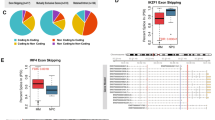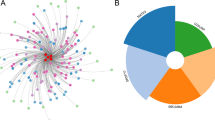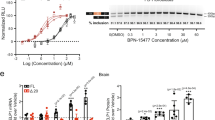Abstract
It is becoming increasingly clear that alternative splicing enables the complex development and homeostasis of higher organisms. To gain a better understanding of how splicing contributes to regulatory pathways, we have developed an alternative splicing library approach for the identification of alternatively spliced exons and their flanking regions by alternative splicing sequence enriched tags sequencing. Here, we have applied our approach to mouse melan-c melanocyte and B16-F10Y melanoma cell lines, in which 5,401 genes were found to be alternatively spliced. These genes include those encoding important regulatory factors such as cyclin D2, Ilk, MAPK12, MAPK14, RAB4, melastatin 1 and previously unidentified splicing events for 436 genes. Real-time PCR further identified cell line–specific exons for Tmc6, Abi1, Sorbs1, Ndel1 and Snx16. Thus, the ASL approach proved effective in identifying splicing events, which suggest that alternative splicing is important in melanoma development.
This is a preview of subscription content, access via your institution
Access options
Subscribe to this journal
Receive 12 print issues and online access
$259.00 per year
only $21.58 per issue
Buy this article
- Purchase on SpringerLink
- Instant access to full article PDF
Prices may be subject to local taxes which are calculated during checkout






Similar content being viewed by others
References
Shoemaker, D.D. et al. Experimental annotation of the human genome using microarray technology. Nature 409, 922–927 (2001).
Zavolan, M. et al. Impact of alternative initiation, splicing, and termination on the diversity of the mRNA transcripts encoded by the mouse transcriptome. Genome Res. 13, 1290–1300 (2003).
Brett, D. et al. EST comparison indicates 38% of human mRNAs contain possible alternative splice forms. FEBS Lett. 474, 83–86 (2000).
Croft, L. et al. ISIS, the intron information system, reveals the high frequency of alternative splicing in the human genome. Nat. Genet. 24, 340–341 (2000).
Liang, F. et al. Gene index analysis of the human genome estimates approximately 120,000 genes. Nat. Genet. 25, 239–240 (2000).
Okazaki, Y. et al. Analysis of the mouse transcriptome based on functional annotation of 60,770 full-length cDNAs. Nature 420, 563–573 (2002).
Krawczak, M., Reiss, J. & Cooper, D.N. The mutational spectrum of single base-pair substitutions in mRNA splice junctions of human genes: causes and consequences. Hum. Genet. 90, 41–45 (1992).
Caceres, J.F. & Kornblihtt, A.R. Alternative splicing: multiple control mechanisms and involvement in human disease. Trends Genet. 18, 186–193 (2002).
Faustino, N.A. & Cooper, T.A. Pre-mRNA splicing and human disease. Genes Dev. 17, 419–437 (2003).
Barrass, J.D. & Beggs, J.D. Splicing goes global. Trends Genet. 19, 295–298 (2003).
Castle, J. et al. Optimization of oligonucleotide arrays and RNA amplification protocols for analysis of transcript structure and alternative splicing. Genome Biol. 4, R66 (2003).
Johnson, J.M. et al. Genome-wide survey of human alternative pre-mRNA splicing with exon junction microarrays. Science 302, 2141–2144 (2003).
Bartel, F., Taubert, H. & Harris, L.C. Alternative and aberrant splicing of MDM2 mRNA in human cancer. Cancer Cell 2, 9–15 (2002).
Loo, J.C. et al. Germline splicing mutations of CDKN2A predispose to melanoma. Oncogene 22, 6387–6394 (2003).
Houghton, A.N. & Polsky, D. Focus on melanoma. Cancer Cell 2, 275–278 (2002).
Stekel, D.J., Git, Y. & Falciani, F. The comparison of gene expression from multiple cDNA libraries. Genome Res. 10, 2055–2061 (2000).
Huang, X. On global sequence alignment. Comput. Appl. Biosci. 10, 227–235 (1994).
Zorn, A.M. Wnt signalling: antagonistic Dickkopfs. Curr. Biol. 11, R592–R595 (2001).
Zhang, Y. et al. Rheb is a direct target of the tuberous sclerosis tumour suppressor proteins. Nat. Cell Biol. 5, 578–581 (2003).
Kaul, R. et al. Direct interaction with and activation of p53 by SMAR1 retards cell-cycle progression at G2/M phase and delays tumor growth in mice. Int. J. Cancer 103, 606–615 (2003).
Sarangarajan, R., Budev, A., Zhao, Y., Gahl, W.A. & Boissy, R.E. Abnormal translocation of tyrosinase and tyrosinase-related protein 1 in cutaneous melanocytes of Hermansky-Pudlak Syndrome and in melanoma cells transfected with anti-sense HPS1 cDNA. J. Invest. Dermatol. 117, 641–646 (2001).
Keresztes, G., Mutai, H. & Heller, S. TMC and EVER genes belong to a larger novel family, the TMC gene family encoding transmembrane proteins. BMC Genomics 4, 24 (2003).
Ramoz, N. et al. Mutations in two adjacent novel genes are associated with epidermodysplasia verruciformis. Nat. Genet. 32, 579–581 (2002).
Sini, P., Cannas, A., Koleske, A.J., Di Fiore, P.P. & Scita, G. Abl-dependent tyrosine phosphorylation of Sos-1 mediates growth-factor-induced Rac activation. Nat. Cell Biol. 6, 268–274 (2004).
Lin, W.H. et al. Cloning, mapping, and characterization of the human sorbin and SH3 domain containing 1 (SORBS1) gene: a protein associated with c-Abl during insulin signaling in the hepatoma cell line Hep3B. Genomics 74, 12–20 (2001).
Liang, Y. et al. Nudel functions in membrane traffic mainly through association with Lis1 and cytoplasmic dynein. J. Cell Biol. 164, 557–566 (2004).
Haft, C.R., de la Luz Sierra, M., Barr, V.A., Haft, D.H. & Taylor, S.I. Identification of a family of sorting nexin molecules and characterization of their association with receptors. Mol. Cell. Biol. 18, 7278–7287 (1998).
Li, B., Cong, F., Tan, C.P., Wang, S.X. & Goff, S.P. Aph2, a protein with a zf-DHHC motif, interacts with c-Abl and has pro-apoptotic activity. J. Biol. Chem. 277, 28870–28876 (2002).
Burge, C. & Karlin, S. Prediction of complete gene structures in human genomic DNA. J. Mol. Biol. 268, 78–94 (1997).
Ge, K. et al. Mechanism for elimination of a tumor suppressor: aberrant splicing of a brain-specific exon causes loss of function of Bin1 in melanoma. Proc. Natl. Acad. Sci. USA 96, 9689–9694 (1999).
Carninci, P. et al. Targeting a complex transcriptome: the construction of the mouse full-length cDNA encyclopedia. Genome Res. 13, 1273–1289 (2003).
Shiraki, T. et al. Cap analysis gene expression for high-throughput analysis of transcriptional starting point and identification of promoter usage. Proc. Natl. Acad. Sci. USA 100, 15776–15781 (2003).
Sazani, P. & Kole, R. Therapeutic potential of antisense oligonucleotides as modulators of alternative splicing. J. Clin. Invest. 112, 481–486 (2003).
Vacek, M., Sazani, P. & Kole, R. Antisense-mediated redirection of mRNA splicing. Cell. Mol. Life Sci. 60, 825–833 (2003).
Mercatante, D.R. & Kole, R. Control of alternative splicing by antisense oligonucleotides as a potential chemotherapy: effects on gene expression. Biochim. Biophys. Acta 1587, 126–132 (2002).
Le Fur, N., Kelsall, S.R., Silvers, W.K. & Mintz, B. Selective increase in specific alternative splice variants of tyrosinase in murine melanomas: a projected basis for immunotherapy. Proc. Natl. Acad. Sci. USA 94, 5332–5337 (1997).
Le Fur, N., Silvers, W.K., Kelsall, S.R. & Mintz, B. Up-regulation of specific tyrosinase mRNAs in mouse melanomas with the c2j gene substituted for the wild-type tyrosinase allele: utilization in design of syngeneic immunotherapy models. Proc. Natl. Acad. Sci. USA 94, 7561–7565 (1997).
Bracco, L. & Kearsey, J. The relevance of alternative RNA splicing to pharmacogenomics. Trends Biotechnol. 21, 346–353 (2003).
Camargo, A.A. et al. The contribution of 700,000 ORF sequence tags to the definition of the human transcriptome. Proc. Natl. Acad. Sci. USA 98, 12103–12108 (2001).
Burset, M., Seledtsov, I.A. & Solovyev, V.V. SpliceDB: database of canonical and non-canonical mammalian splice sites. Nucleic Acids Res. 29, 255–259 (2001).
Wang, H. et al. Gene structure-based splice variant deconvolution using a microarry platform. Bioinformatics 19 Suppl 1, I315–I322 (2003).
Carr, K.M., Bittner, M. & Trent, J.M. Gene-expression profiling in human cutaneous melanoma. Oncogene 22, 3076–3080 (2003).
Chin, L. The genetics of malignant melanoma: lessons from mouse and man. Nat. Rev. Cancer 3, 559–570 (2003).
Bowtell, D. & Sambrook, J. (eds.). DNA Microarrays: A Molecular Cloning Manual (Cold Spring Harbor Laboratory Press, New York, 2003).
Acknowledgements
We thank E.V. Sviderskaya for providing cells from the Wellcome Trust Functional Genomics Cell Bank, W.J. Pavan for supplying RNA and encouragement, T. Hayashi for support and encouragement, H. Nishibe for secretarial assistance and N. Harigai for technical assistance. A Research Grant for the RIKEN Genome Exploration Research Project from the Ministry of Education, Culture, Sports, Science, and Technology of the Japanese Government to Y.H. and a RIKEN Presidential Research Grant for Innovation Tool Development to P.C. supported this study.
Author information
Authors and Affiliations
Corresponding authors
Ethics declarations
Competing interests
The authors declare no competing financial interests.
Supplementary information
Supplementary Fig. 1
New splicing events identified by sequencing of ASLs. (PDF 22 kb)
Supplementary Fig. 2
Computational Analysis and Annotation of ESTs and ASSETS (PDF 41 kb)
Supplementary Fig. 3
RT-PCR Analysis of randomly Selected ASSETS (PDF 271 kb)
Supplementary Fig. 4
ASSETS and full-length sequences for Aph2 (PDF 28 kb)
Supplementary Fig. 5
Curves for Real-time RT-PCR Experiments (PDF 267 kb)
Supplementary Table 1
Computational Analysis of ASSETS – 1 (PDF 27 kb)
Supplementary Table 2
Computational Analysis of ASSETS – 2 (PDF 13 kb)
Supplementary Table 3
Annotation of EST and ASSETS (PDF 12 kb)
Supplementary Table 4
High-quality targets Selected to Characterized Splice Types (PDF 101 kb)
Supplementary Table 5
Statistical analysis of splice types found in high- quality targets, and their location within the transcripts. (PDF 842 kb)
Supplementary Table 6
Important Genes Identified by ASSETS (PDF 14 kb)
Supplementary Table 7
Primers and Probes Used for Colony Hybridization (PDF 39 kb)
Supplementary Table 8
ASSETS specific Primer Sets for RT-PCR (PDF 15 kb)
Supplementary Table 9
ASSETS specific Primer Sets for Real-time PCR (PDF 27 kb)
Supplementary Methods
Preparation of ASLs, Colony Hybridization, RT-PCR, real-time PCR, and Sequencing (PDF 44 kb)
Rights and permissions
About this article
Cite this article
Watahiki, A., Waki, K., Hayatsu, N. et al. Libraries enriched for alternatively spliced exons reveal splicing patterns in melanocytes and melanomas. Nat Methods 1, 233–239 (2004). https://doi.org/10.1038/nmeth719
Received:
Accepted:
Published:
Issue date:
DOI: https://doi.org/10.1038/nmeth719
This article is cited by
-
Regulation of the actin cytoskeleton by the Ndel1-Tara complex is critical for cell migration
Scientific Reports (2016)
-
Improving mRNA 5′ coding sequence determination in the mouse genome
Mammalian Genome (2014)
-
Characterization, expression profile, polymorphism and association of porcine NAT9 gene
Molecular Biology Reports (2012)
-
Interaction Between Syntaxin 8 and HECTd3, a HECT Domain Ligase
Cellular and Molecular Neurobiology (2009)
-
Efficient targeted transcript discovery via array-based normalization of RACE libraries
Nature Methods (2008)



